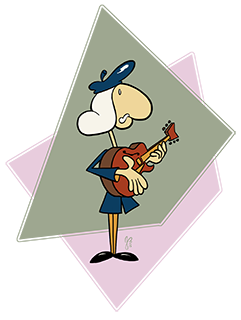I'm already aware that the diminished sound can be applied with any dominant. The 'half-whole' symmetrical diminished scale can be used from the root of a V to get altered tones, but what about Diminished chords in Bossas or even folk and classic show tunes?
The best I can gather, the Diminished is like connective tissue that links the meat of the Diatonic chords. Altered sounds on a Five chord is really just a way to lead the ears back to the I chord, often chromatically instead of scale-wise. When you see a Dim.7 for a whole bar, typcially the same idea is happening -- it is a chromatic walk to the next harmony. My plan is to get a baseline visualization for any diminished around the Major scale and then adjust accordingly. My approach -- outlined in the PDF below -- is inspired by the bars in 'Shadow of Your Smile' which moves from Cmaj7 to C#dim7.
| diminished_over_major.pdf |
The first goals is to learn how these shapes 'sit' against the 'mode boxes' of the fretboard. I visualize the fretboard by segments where you can vertically play a mode with the mode's root on the sixth string. I'm learning these 'anchors' by looping two bars of Cmaj7 followed by two bars of Diminished 7. For each mode-box, I start slow and work up speed alternating between the Major scale and then the arpeggio. From these anchors I am extending the diminished arpeggio shape out. The ensuing pages 2-8 show arpeggio shapes for other strings. As I practice, I'm starting just with the 'corny' arpeggios as a line back to the major scale harmony. For each segment of the fretboard, I want to visualize the map of these arpeggios over the major scale.
Page 9 of the PDF begins the rest of the half-whole 'Symmetrical Diminished'. The second 'half' of the scale is rendered for each shape on page 1-8. The other half of the half-whole scale is the same arpeggio voicings, just one semi-tone up from the anchors.
The 'Symmetrical Diminished' is a synthetic scale comprised of two sets of diminished arpeggios. Every other note has a semi-tone or whole-tone interval. The pages 9-16 show what I am calling the 'consonant' half of the scale. All the notes of the scale one semi-tone up are in the Major scale, save the #5. Even though #5 is not classically consonant with the major scale, it is okay to resolve on a Maj7#5 chord. The #5 is consonant in the Barry Harris world.
The arpeggios in pages 1-9 I will call the 'Dysonant' half of the scale. Even though they have a Perfect Third and Perfect Fifth, you are never going to resolve a Major 7 chord with flat 9 or a flat 7. These are the same arpeggios in the 'Sixth to Diminished' concept. They are the diminished arps that alternate between Maj6/min7 voicings to complete the Barry Harris chord scale.
Interesting, the 'Consonant'arpeggios have the voicings you might use for a V7b9 chord. The major #5 is the b9 of the Dominant chord in a Major key.
Together, both the 'Consonant' and 'Dysonant' arpegios make up my Symmetrical diminished scale for navigating over a C#o7 from a Cmaj7. The end goal is to be able to go into this scale at any point, from any point in any Major scale.
Of course this pdf leaves out a third set of diminished arpeggios, which contains the root, the b3, the sixth, and the #11 of the major. These arpeggios lead to other Symmetrical Diminished scales which I am not going into in order to keep things from getting too out of hand. If you think of the 'altered Five' application of the Symmetrical Diminished using the scale in the PDF (the 'anchors' combined plus a semi-tone up) gives you the b9, #9, #11, as well as the root, the third, sixth and the b7 of the Five chord. The only alteration you are missing is the #5 of the Five. In the end, in order to play the remaining Symmetrical Diminished scale, you would simply use the 'anchor' voicings in page 1-9 as 'avoid' notes -- avoiding the Major scale's 5, b9, b7 and P3. In terms of the Five chord, that would mean avoiding the 5, 7, #11, and #3 of the Dominant.
By learning the 'anchors' in page 1 for each mode-box, then learning the other voicings connected to them, then adding the notes a semi-tone up, I hope to get a go-to framework for coming up with diminished sounds relating to the major scale.

 RSS Feed
RSS Feed
